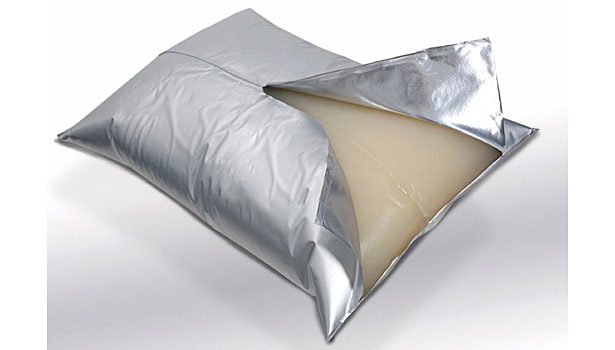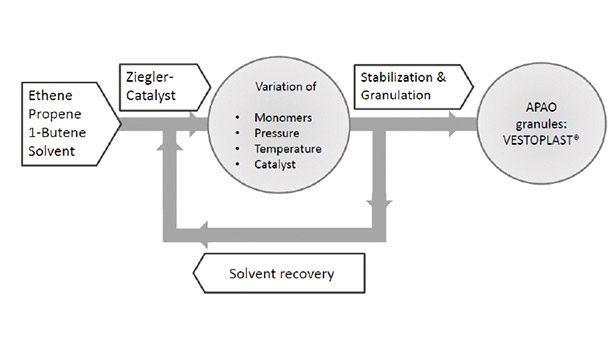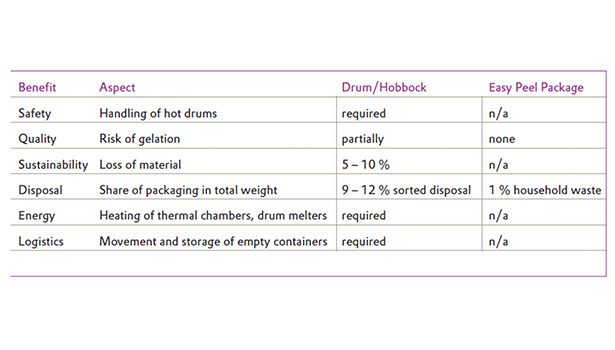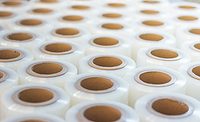The expression “old wine in new bottles” refers to dressing an old, well-worn idea in new garb. Evonik has shown that new packaging for an existing product may also represent a genuine innovation — as in the case of its easy-peel package for the moisture-curing silane-modified amorphous polyalphaolefin (APAO) VESTOPLAST® 206.
Amorphous polyalphaolefins (APAO), which Evonik markets as VESTOPLAST®, are copolymers and terpolymers of ethene, propene, and 1-butene, produced in a low-pressure polymerization process with Ziegler catalysts (see Figure 1). They offer very high thermal stability, good flexibility and very good adhesion to nonpolar surfaces. Moreover, APAO-based hot melts are formulated with lower proportions of resin compared with other classes of polymer, making these systems mostly independent of resin availability. In addition, supplies and availability of the olefin monomer raw materials are more robust and less volatile than for other base polymers.
The base polymer’s physical properties are crucial in determining the property profile of a formulated thermoplastic hot melt. The VESTOPLAST® production process allows targeted control of the incorporated co-monomers, stereochemistry and molecular weight distribution. As a result, polymer properties such as melt viscosity, softening point and hardness, crystallinity, open time, and mechanical properties can be varied, so that a variety of different grades are available for formulation of thermoplastic adhesives. The molecular weight (MW) spectrum of the polymers ranges from 34,000 to 120,000 g/mol. A distinction is made between propene-rich (C3 proportion > 50%) and butene-rich (C4 proportion > 50%) grades.
Applications for VESTOPLAST® include profile wrapping and edge banding in the wood industry, mattress bonding and diaper bonding in the hygiene industry, and lamination and fixing of polypropylene (PP) parts in the packaging market. In all these cases, the hot-melt adhesive benefits from VESTOPLAST®’s hot tack properties and excellent adhesion. However, some application fields place very high demands on the hot-melt adhesive, which presents a challenge for purely thermoplastic adhesives. For bonded joints in automotive interiors, for example, it is not uncommon for the shear adhesion failure temperature required to exceed 120°C. The substrates there increasingly consist of PP, which is preferably bonded or laminated without pre-treatment as far as possible. Requirements are also high in the area of adhesive and sealing compounds for double and triple glazing of windows and for thin-film solar cells on glass.
High thermal resistance is also important in these applications. The bond must remain flexible with fluctuating temperatures over the seasons, and must accommodate mechanical deformation. Adhesion to glass poses a particular challenge; specifically, atmospheric moisture must not migrate along the bonded surfaces, and any protective gases present must remain confined. This also applies to the adhesive and sealant compounds; they must be impermeable to water vapor and hard-wearing as well—and must remain so over several decades.
VESTOPLAST® 206 is designed for these special requirements. This silane-modified, moisture-curing grade provides improved adhesion without pretreatment, even to polar substrates. Silane modification over the entire polyolefin backbone allows reactive bonding to the substrate so that even very different surfaces, such as glass and PP, can be joined without pretreatment. Moreover, crosslinking of polymer chains also contributes to cohesion, improving tensile strength, elasticity, and water vapor tightness. The crosslinking reaction is initiated by moisture alone and can be accelerated by catalysts.
Optimized Packaging
VESTOPLAST® 206 is not subject to mandatory labeling. The product is produced from an amorphous terpolymer melt to which silane groups are chemically grafted. It combines the advantageous properties of an amorphous polyalphaolefin with the reactive properties of the silanes. However, the now moisture-sensitive polymer melts must then be filled into appropriate packaging.
The special challenge in the development of optimal packaging comes from the intrinsic properties of the product: The very same property that is so desirable in the end application for bonding to substrates can be a serious disadvantage when it comes to packaging the product; the product must not adhere so firmly to the packaging that it cannot be separated from it.
Apart from general requirements on packaging, such as minimal weight and volume, simple and safe handling, and easy and cost-effective disposal, additional product-specific requirements are important. The packaging must withstand temperatures of up to 160°C, the temperature at which hot-melt adhesive materials are generally filled. It must also be highly impervious to traces of moisture to prevent premature crosslinking or gelling of the product. Moreover, it must be possible to empty the product completely from the packaging without leaving any residue.
Developed by Evonik in collaboration with packaging and machine manufacturers, the new Easy Peel packaging satisfies all the above-mentioned requirements and also offers the customer cost advantages over the conventional packaging forms. These are usually provided in 20-kg hobbocks or 200-kg steel drums, which incur higher logistics and disposal costs. The new Easy Peel package offers a moisture-resistant and non-adhesive packaging solution with safer and simpler handling properties. Laborious use of hobbocks and drums is now a thing of the past, and the moisture-sensitive product does not decrease in quality during transfer.
The material is available as a 10-kg pack, opening up new application possibilities. In the adhesives industry, drum-heating rooms or drum melting systems are usually available, albeit with the above-mentioned disadvantages; however, this is not always true of the sealing compound industry. Here, some limits are imposed on the use and processing of hot melts; however, block products, such as rubber bales, are usually processed in kneaders. The Easy Peel packaging makes it possible for even these producers to use VESTOPLAST® 206 in reactive sealing compounds. The new packaging form makes kneading of the individual components during manufacture of adhesive sealing compounds uncomplicated and problem-free.
A patent application has been filed for the packaging for reactive adhesive raw materials and hot melts. VESTOPLAST® 206 is already available in the new Easy Peel packages.
For more information, contact the author at andre.ebbers@evonik.com or (49) 2365-49-2502, or visit www.evonik.com/designed-polymers.





